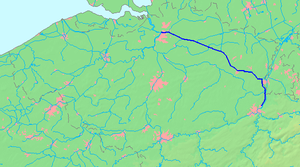Albert Canal
| Albert Canal | |
|---|---|
 | |
| Specifications | |
| Locks | 6 |
| History | |
| Date of first use | 1939 |

The Albert Canal (Dutch: Albertkanaal, French: Canal Albert) is a small and shallow canal located in northeastern Belgium, which was named for King Albert I of Belgium. The Albert Canal connects Antwerp with Liège, and also the Meuse River with the Scheldt River. It also connects with the Canal Dessel-Turnhout-Schoten, and its total length is 129.5 kilometres (80.5 mi).
The Albert Canal has a standard depth of just 3.4 metres (11 ft) and an overhead clearance of just 6.7 metres (22 ft). The largest vessels that can use this canal are barges of just 10,000 tons - much smaller than the ones on the Rhine or the Danube or the ones in the waterways of the United States and Canada.
Between Antwerp and Liège, there is a difference in elevation of 56 metres (184 ft), and six sets of canal locks were needed to overcome this difference. Five canal locks each have a lift of 10 metres (33 ft), and these are located in Genk, Diepenbeek, Hasselt, Kwaadmechelen, and Olen, Belgium. The sixth lock at Wijnegem has a lift of 5.45 metres (17.9 ft).
During most of the 1930s, before the completion of the Albert Canal, it took about seven days to travel from Antwerp to Liege by water. In the 21st century, that same distance can be covered in about 18 hours.
History

The Albert Canal was constructed from 1930 through 1939. The German construction company Hochtief AG worked on the canal between 1930 and 1934, but then it was completed by Belgian companies.
The Albert Canal was used for the first time in 1940, but because of World War II, it intensive use began later, in 1946.
During World War II, the Albert canal functioned as a defense line. It was used not only to defend part of Belgium, but it also became the northeastern arrondissements of France. The crossing of the canal by the Nazi German Wehrmacht and the destruction of the Fort Eben-Emael on May 11, 1940, was a milestone in the German invasion of Belgium.
During the liberation of Belgium by foreign armies, in September 1944, the Second Canadian Division was the first Allied unit to cross the Albert Canal.[citation needed] This was part of the First Canadian Army. The British Army also crossed the Albert Canal on its way north across Belgium and into The Netherlands, and the U.S. Army entered Belgium farther to the east on its way to liberate the rest of Belgium, and Luxembourg, and then proceed east to invade Nazi Germany.[citation needed] Hence, Belgium was liberated from the south by three different armies, two of which needed to cross the Albert Canal.[citation needed]
